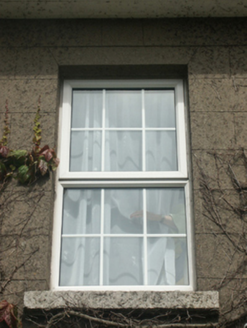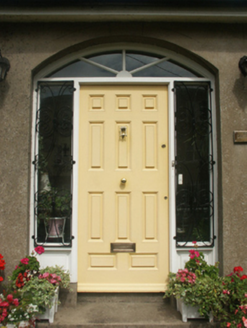Survey Data
Reg No
15502155
Rating
Regional
Categories of Special Interest
Architectural, Artistic, Historical, Social
Original Use
Presbytery/parochial/curate's house
In Use As
House
Date
1835 - 1845
Coordinates
304611, 121663
Date Recorded
07/07/2005
Date Updated
--/--/--
Description
Detached five-bay two-storey presbytery, built 1840, on a T-shaped plan centred on single-bay single-storey projecting porch to ground floor. Sold, 1883. Occupied, 1901; 1911. Renovated, ----. Hipped slate roof with clay ridge tiles, rendered chimney stacks on axis with ridge having capping supporting terracotta pots, and cast-iron rainwater goods on slightly overhanging timber boarded box eaves retaining cast-iron downpipes. Part creeper- or ivy-covered rendered, ruled and lined walls with rusticated rendered quoins to corners. Segmental-headed central door opening (porch) with two concrete steps, timber mullions supporting timber transom, and concealed dressings framing timber panelled door having sidelights on panelled risers below fanlight. Square-headed window openings with cut-granite sills, and concealed dressings framing replacement uPVC casement windows replacing six-over-six timber sash windows. Set back from line of street in landscaped grounds with wrought iron railings to perimeter centred on rendered piers having shallow pyramidal capping supporting iron double gates.
Appraisal
A presbytery representing an important component of the mid nineteenth-century built heritage of Wexford with the architectural value of the composition, one occupied by Reverend James Roche (1801-83), suggested by such attributes as the compact rectilinear plan form centred on a restrained doorcase, albeit one largely concealed behind a replacement porch; the slight diminishing in scale of the openings on each floor producing a feint graduated visual impression; and the slightly oversailing high pitched roofline. Having been well maintained, the elementary form and massing survive intact together with substantial quantities of the original fabric, both to the exterior and to the interior where contemporary joinery; and plasterwork refinements, all highlight the modest artistic potential of the composition: however, the introduction of replacement fittings to the openings has not had a beneficial impact on the character or integrity of a presbytery making a pleasing visual statement in Waterloo Road.





